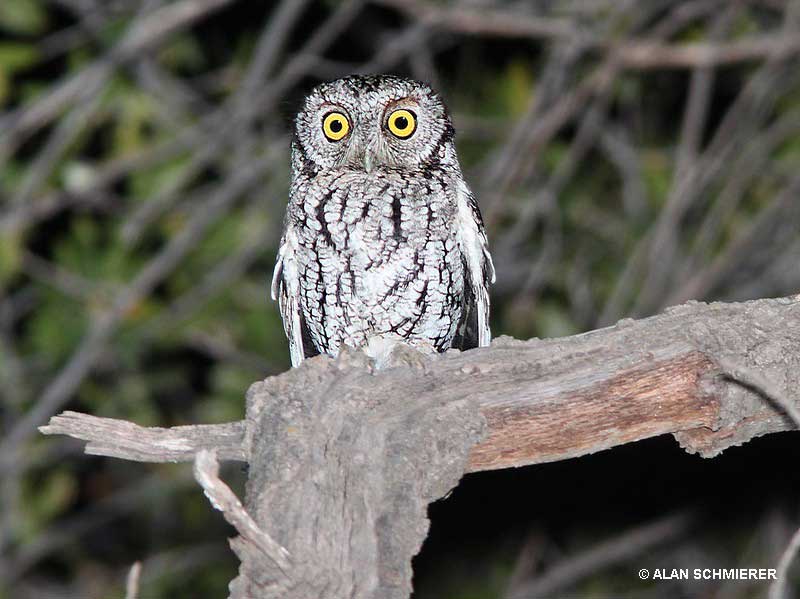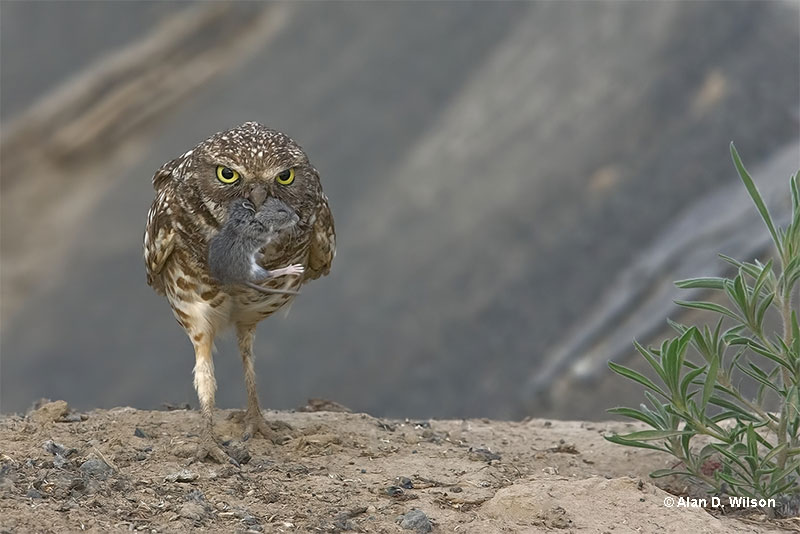
Do owls live in Arizona? Yes! Many owls in Arizona live in the state’s deserts, canyons, and montane forests.
Although most of the owls of Arizona come out at night, a few species are active during the day.
Have you seen an owl in Arizona? See this article to identify and learn all about the owls you can see in Arizona!
On this page
Owls You Can See in Arizona
According to eBird data and USGS data, 10 owl species are commonly seen in Arizona. 3 more owl species also occur in Arizona but only as rare visitors.
It can take some effort to see the common species and the rare ones are much more challenging but, with luck, maybe you can see them too! To help you recognize all the common and rare owls in Arizona, our list includes identification tips and other useful information.
We also arranged the owls from the most common to least common.
1. Great Horned Owl (Most common owl)
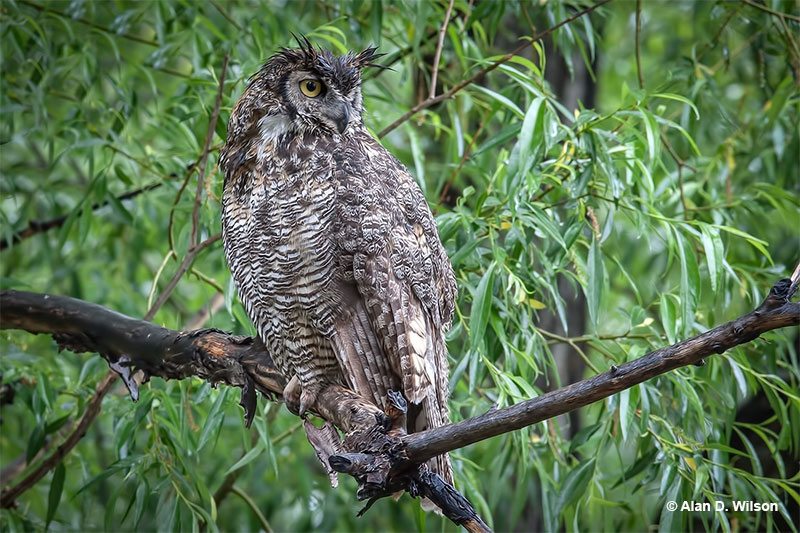
- Range: Permanent resident in much of Alaska, Canada, and the USA.
- Length: 22 inches
- Wingspan: 44 inches
- Call: Makes a low, gruff, “hooo, hoo hoo hoo hoooo”.
The Great Horned Owl is a big, bulky owl with big ear tufts and a black beak. It is mottled gray and brown, has a rufous or gray face, and fine black barring on its underparts. This owl also has a white throat and some dark marks on its breast.
Males and female Great Horned Owls look the same but females are larger. They also have a medium-length tail with dark bands, and long, broad wings.
This nocturnal owl species lives in every possible habitat, including urban areas.
Key Identifications:
- Big, bulky brown or gray owl with ear tufts and fine barring on its underparts.
- Nests in old stick nests of other large birds, on ledges, and in other situations.
- Watches from a perch or glides over open habitats at night, to catch mammals and some birds on the ground.
The Great Horned Owl lives in every type of habitat in much of North America, including Arizona. It nests in old stick nests of hawks and other birds, or on ledges, and other situations. Great Horned Owls are easily recognized by their big, bulky size, ear tufts, and finely barred underparts. The talons and grip of this species are so strong, once closed, 28 pounds of pressure are needed to open them!
2. Western Screech-Owl
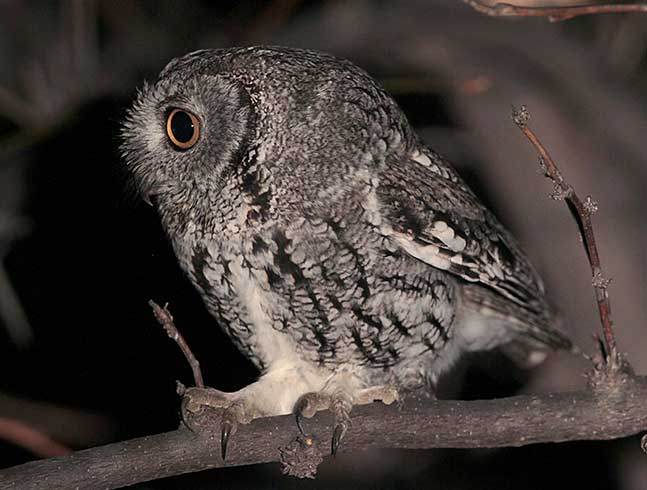
- Range: Permanent resident in British Columbia and the western USA.
- Length: 8.5 inches
- Wingspan: 20 inches
- Call: Has a “bouncing ball” song of short notes, “whup…whup..whu,whu,whu,whu,waa”.
The Western Screech Owl is a small brown or gray owl with ear tufts. It has “V”-shaped pale eyebrows, and some black on the edge of its face. This owl also has mottled upperparts with some white marks, and pale underparts with dark barring and streaks.
Males and females look similar but females are a bit larger. This species also has broad, rounded wings and a broad tail.
This nocturnal owl species lives in a wide variety of woodland and open habitats.
Key Identifications:
- Small, brownish or gray owl with ear tufts, a black border on the edge of its face, some dark streaks and markings on its underparts, and some white marks on its shoulder.
- Lives in many wooded and forest habitats.
- Nests in tree cavities and nest boxes.
- Watches from a perch before flying to catch small animals on the ground and from vegetation at night.
The Western Screech Owl lives in parks and many other woodland habitats in British Columbia, the western USA, including Arizona, and Mexico. It nests in tree cavities, and can be recognized by its small size, ear tufts, fine streaks on its underparts, and calls. This species is nocturnal but often becomes active just before nightfall.
3. Burrowing Owl
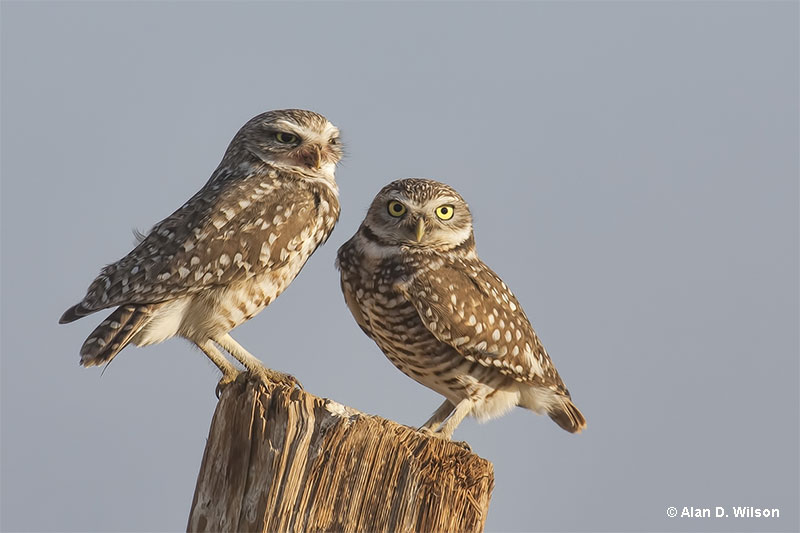
© Alan D. Wilson
- Range: Summer resident in central-southern Canada, the Great Plains, and much of the western USA. Permanent resident in California, Texas, and Florida.
- Length: 9.5 inches
- Wingspan: 21 inches
- Call: Makes a raspy, chattering call, “rap, rip,rip,rip,rip”, and a quail-like, “whup waaah!”.
The Burrowing Owl is a small, long-legged owl with a white throat and white eyebrows. It has a round head, is dark brown with white spots above, and has pale underparts with dark barring.
Males and females look alike although females are a bit larger. Young birds are uniform dark brown and buff.
Related: How long do owls live?
Adult Burrowing Owls in Florida are more heavily marked below than western birds but juveniles from Florida are paler.
The Burrowing Owl is active day and night in grasslands, deserts, and other open habitats. Burrowing Owls are one of the most common owl species of Arizona.
Key Identifications:
- Small, long-legged owl with a round head, and some brown barring on pale underparts.
- Lives in grasslands and other wide-open habitats.
- Nests in burrows made by prairie dogs and other animals although birds in Florida make their own burrows.
- Catch small animals on the ground at any time of the day or night.
The Burrowing Owl occurs in open habitats in south-central Canada, the western USA, and Florida. It nests in burrows. Burrowing Owls are easily identified by their small size, round head, barred underparts, and terrestrial behavior. Like some other animals that live in burrows, this species is more tolerant of carbon dioxide than other birds.
4. Elf Owl
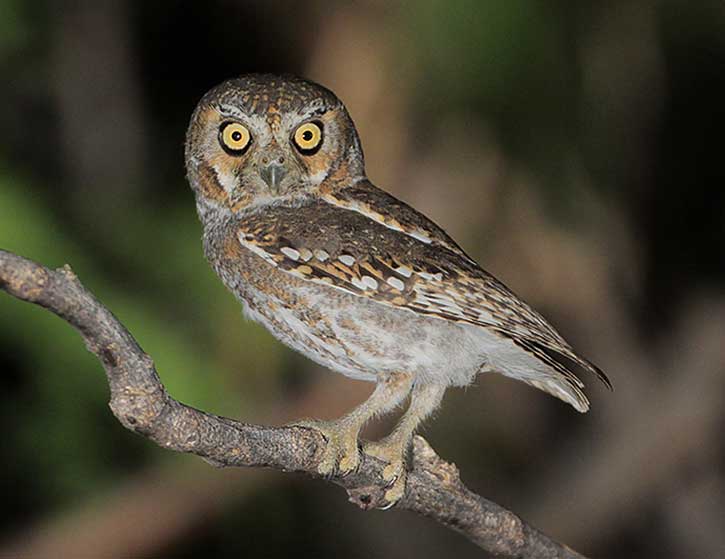
- Range: Summer resident in parts of Arizona, New Mexico, and southern Texas.
- Length: 5.75 inches
- Wingspan: 13 inches
- Call: Makes rising and descending yipping calls, “kup kip,kip,kip,kip,kup”.
The Elf Owl is a tiny, sparrow-sized owl with a round head and yellow eyes. It is soft gray and brown and has a plain brown face with white eyebrows. It also has white wing bars, and some thick brown streaks below.
Males and females look the same although females are a bit larger. They also have yellow eyes, a dark beak, and fairly long, feathered legs and toes.
This species migrates to Mexico for the winter.
Key Identifications:
- Tiny brown and gray owl with a round head and pale underparts with a few thick blurry streaks.
- Lives in desert habitats and evergreen woodlands up to 6,000 feet in elevation.
- Nests in cavities in trees, wooden telephone poles, and saguaro cactus.
- Catches insects and small animals at night, in flight, on the ground, and in foliage.
The Elf Owl breeds in desert and evergreen woodland habitats in Arizona, New Mexico, and western and southern Texas. It winters in Mexico. Elf Owls are identified by their tiny size, round head, short tail, and blurry streaks on their underparts. This sparrow-sized bird is the smallest owl species in the world.
5. Whiskered Screech-Owl
- Range: Permanent resident in mountains of southeastern Arizona.
- Length: 7.25 inches
- Wingspan: 17.5 inches
- Call: Makes five repeated tooting or high-pitched hoot calls, “tuoot tu tu tu tu”.
The Whiskered Screech Owl is a small, gray owl species with ear tufts and yellow-orange eyes. It has “V”-shaped pale eyebrows, and some black on the edge of its face. This bird is also mottled gray and white above, and has thick, short dark streaks and barring on pale underparts.
Male and females look the same but females are slightly larger.
This nocturnal owl resides in montane oak and coniferous woodlands.
Key Identifications:
- Small, mottled gray owl with bits of brown, ear tufts, a black border on the edge of its face, orange-yellow eyes, thick dark streaks and markings on its underparts, and small white markings on its back.
- Lives in oak and coniferous woodlands.
- Nests in tree cavities.
- Watches from a low perch before flying to catch insects and small animals at night.
The Whiskered Screech Owl lives in oak, sycamore, and pine woodlands and canyons from southeastern Arizona to Central America. It nests in tree cavities, and is identified by its small size, ear tufts, mottled gray plumage with bits of brown, thick, dark streaks below, and vocalizations. This species lives with the similar Western Screech Owl in some areas but usually replaces it at higher elevations.
6. Barn Owl
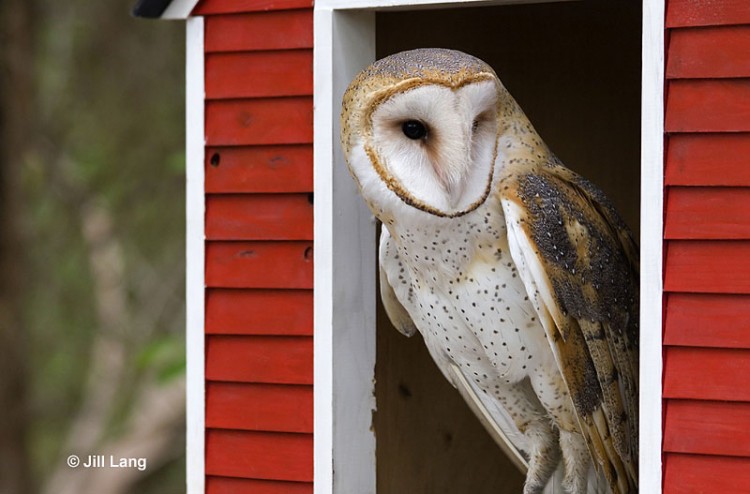
- Range: In Canada, occurs mostly in southwestern British Columbia. In the USA, they live in many areas but are absent from mountains and cold, northern regions. They range north to Washington, Nebraska, Iowa, and New York.
- Length: 16 inches
- Wingspan: 42 inches
- Call: A shrill, loud, hissing “shriiiiii!”
The Barn Owl is a medium to large, pale owl with golden tan and gray upperparts, and white underparts. It has a distinctive, white, heart-shaped face.
Both sexes are alike but females are a bit larger than males and have buff on their chest.
In flight, Barn Owls look like a large, pale, moth-like bird with a big, rounded head.
This owl hunts in grasslands, farms, and other open habitats.
Key Identifications:
- Large pale owl with a heart-shaped face.
- Glides and flutters over fields and other open areas at night.
- Nests in tree cavities, crevices in church steeples and other structures, and next boxes.
- Preys on rats and other small animals.
The Barn Owl lives in many urban and open habitats in regions with mild or no winters. It nests in church steeples, barns, tree cavities, and other similar situations. They are common owls in Arizona. This species is easily recognized by its white, heart-shaped face, and unstreaked, pale plumage. Barn Owls have incredible hearing that helps them catch prey in total darkness.
7. Northern Pygmy-Owl
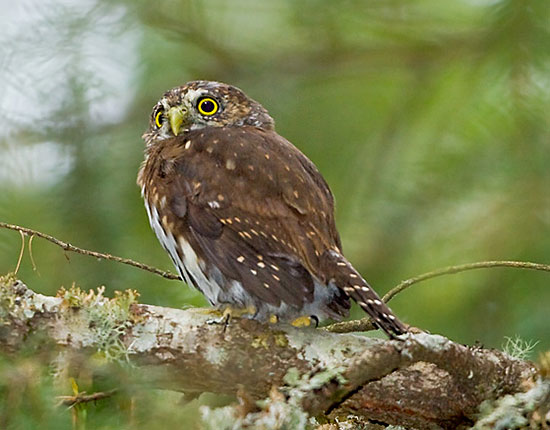
- Range: Permanent resident in the southern half of British Columbia and parts of Alberta, and in mountains and coastal forests of the western USA.
- Length: 6.75 inches
- Wingspan: 12 inches
- Call: Makes a single, well-spaced, whistled “Toot!” call.
The Northern Pygmy Owl is a small, grayish-brown owl with two large black marks on the back of its head. It also has small white spots on its head, breast, and flanks, a longish banded tail, and dark streaking below.
Both sexes of this small owl look the same but females are slightly larger than males.
This uncommon diurnal owl lives in oak and coniferous forest habitats.
Key Identifications:
- Small, dark brown owl with two black marks on the back of its round head, dark brown streaks on pale underparts, and longish dark tail with narrow white bands.
- Lives in forest habitats in western Canada and the western USA south to northern Central America.
- Nests in old woodpecker holes and natural tree cavities. It can also use nest boxes.
- Watches from a perch before flying out to catch small birds during the day.
The Northern Pygmy Owl lives in forest habitats in western Canada and the western USA. Northern Pygmy Owls can be recognized by their small size, round head, and narrow pale bands on a longish, dark tail. Small birds often mob this species and can lead birders to the owl as they try to drive it away from their territories.
8. Spotted Owl
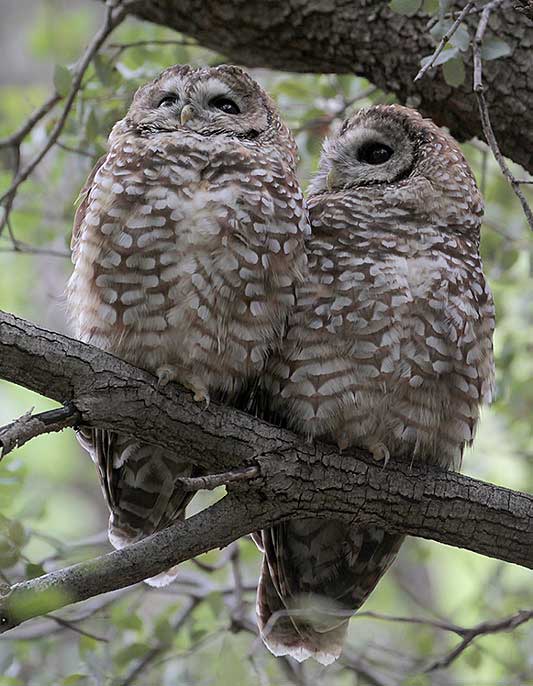
Photograph © Greg Lavaty
- Range: A permanent resident in the Pacific Northwest, the Sierra Nevada, and mountains in the southwestern USA.
- Length: 17.5 inches
- Wingspan: 40 inches
- Call: Makes abrupt, bark-like hoots, “whoot….oot oot..hoo…whew”.
The Spotted Owl is a medium-sized owl with a round head, dark eyes, and a narrow black border on its pale brown face. It also has dark brown upperparts with pale markings, and dark brown and white spotting on its underparts.
Males and females look the same but females are a bit larger. This species also has broad wings and dark bands on its broad tail.
This uncommon, nocturnal owl lives in mature coniferous and oak forests.
Key Identifications:
- Medium-sized, dark brown owl with white spotting on its back and flanks, and a round head.
- Lives in mature forest and woodlands.
- Nests in old raptor nests, in tree cavities, and on top of broken off trees.
- Watches from a perch before flying down to catch small animals on the ground, at night.
The Spotted Owl is a rare resident of mature forest, mostly in parts of the western and southwestern USA, including Arizona, and Mexico. It nests in old raptor nests, tree cavities, and broken off tree tops. Spotted Owls are identified by their round heads and white spotting on their brown flanks and back. In most parts of its range, this species requires old forest with healthy populations of its main prey; the Northern Flying Squirrel.
9. Long-eared Owl
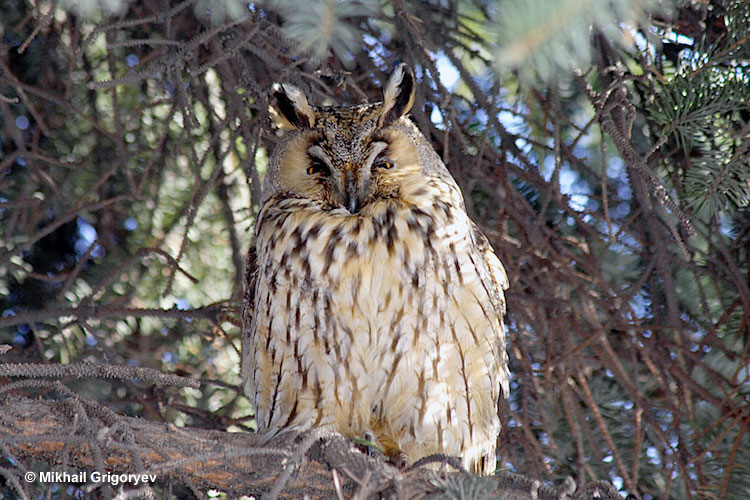
- Range: Migrant in southern Canada, resident and winters in much of the USA. Absent from parts of the Pacific Northwest and southeastern states.
- Length: 15 inches
- Wingspan: 36 inches
- Call: Makes a single, one second long “Hooo!” call at regular intervals.
The Long-eared Owl is a medium-sized, slender owl with long ear tufts. It has an orange face, is mottled gray above, and has dark brown streaks and marks on pale underparts. This owl also has long wings with a rufous patch in its primaries.
Male and female Long-eared Owls look similar but females are larger. This owl species also has yellow eyes, and some pale markings between its eyes and around its dark beak.
This nocturnal owl frequents coniferous woodlands near meadows.
Key Identifications:
- Medium-sized, slender owl species with long ear tufts, orange on its face, and long wings with an orange-brown patch near the wingtips.
- Occurs in coniferous and mixed forests near meadows, bogs, and other open areas.
- Nests in old crow, magpie, and hawk nests.
- Glides over open habitats near forest at night to catch small animals on the ground.
The Long-eared Owl occurs in forest with open areas in Canada and much of the lower 48 states. This owl nests in old magpie, crow, and hawk nests. Long-eared Owls can be recognized by their long ear tufts, orange face, slender appearance, and long wings with orange-brown patches near the wingtips. Wintering roosts of Long-eared Owls in Serbia can host thousands of birds!
10. Flammulated Owl
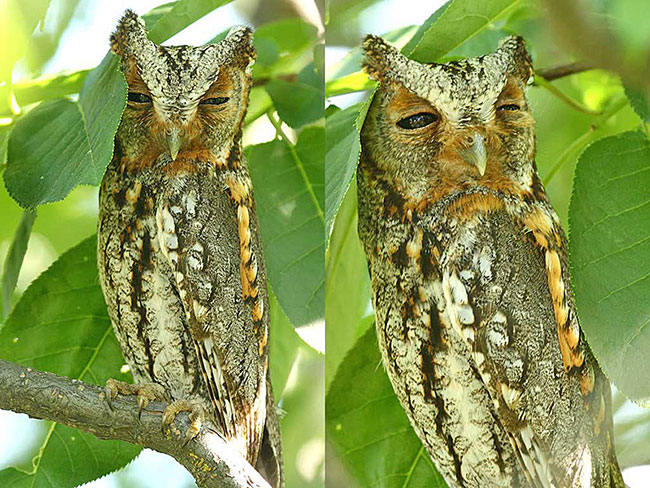
- Range: Summer resident in a small area of southern British Columbia, and in mountains in the western USA.
- Length: 6.75 inches
- Wingspan: 16 inches
- Call: Makes one, low-pitched “woot” call at regular, well-spaced intervals.
The Flammulated Owl is a small, thrush-sized owl with short ear tufts and dark eyes. It is mottled gray and reddish brown with pale eyebrows and some white spotting. This owl also has thick black streaks on mottled gray and white underparts.
Males and females look the same although females are a bit bigger. This species also has long wings and a short, broad tail.
Key Identifications:
- Small, mottled gray and reddish-brown owl with ear tufts and dark eyes.
- Breeds and winters in montane forest habitats.
- Nests in old woodpecker holes.
- Picks moths and other insects from foliage in flight, at night.
The Flammulated Owl breeds in Aspen, Ponderosa Pine, and other montane forest habitats in southern British Columbia, the western USA, including Arizona, and Mexico. It migrates to montane habitats in Mexico and Central America for the winter.
This owl nests in old woodpecker holes and is recognized by its small size, ear tufts, reddish-brown highlights, and dark eyes. The calls of this species are surprisingly low-pitched but, sounding like a larger owl could help scare off potential predators.
Rare Owls in Arizona
11. Northern Saw-whet Owl
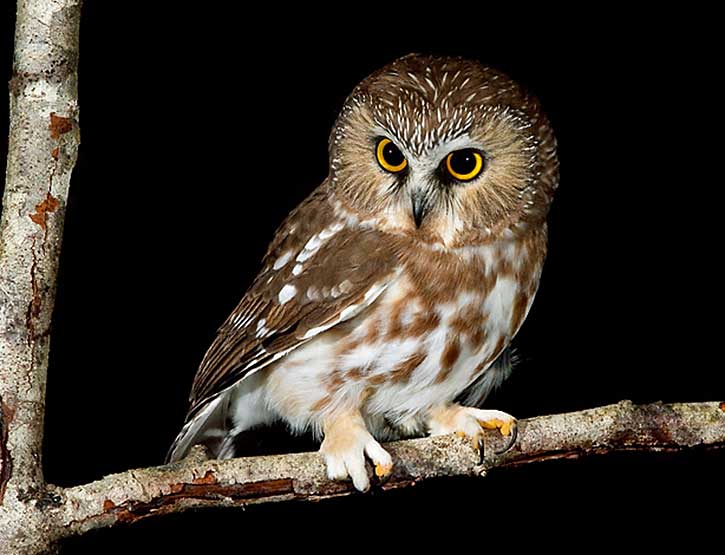
- Range: Lives in coniferous and mixed hardwood forests of Alaska, a large area of Canada, and parts of the northern and western USA.
- Length: 8 inches
- Wingspan: 17 inches
- Call: Makes a repeated tooting whistle call, over and over, “tu, tu, tu, tu, tu, tu, tu, tu, tu”.
The Northern Saw-whet Owl is a small, dark brown owl with a round head and brown streaks on white underparts. It also has some pale streaks on its head, a brown and white face, and some white spotting on its back.
Both sexes look the same but females are a bit larger. This species also has yellow eyes, a dark beak, longish, rounded wings, and a short, broad tail.
This nocturnal owl lives in forested habitats.
Key Identifications:
- Small, dark brown owl with a round head, broad white eyebrows, and thick dark streaks on pale underparts.
- Occurs in dense coniferous and mixed forest.
- Nests in old woodpecker holes and can use nest boxes.
- Swoops down to catch insects and small animals at night.
The Northern Saw-whet Owl breeds in coniferous and mixed forest in Canada and the northern and western USA, including Arizona. It nests in old woodpecker holes and is identified by its small size, round head, thick white eyebrows, and thick streaks on pale underparts. The name of this owl refers to the similarity of its call to the sound made by sharpening an antique old saw blade.
12. Ferruginous Pygmy-Owl
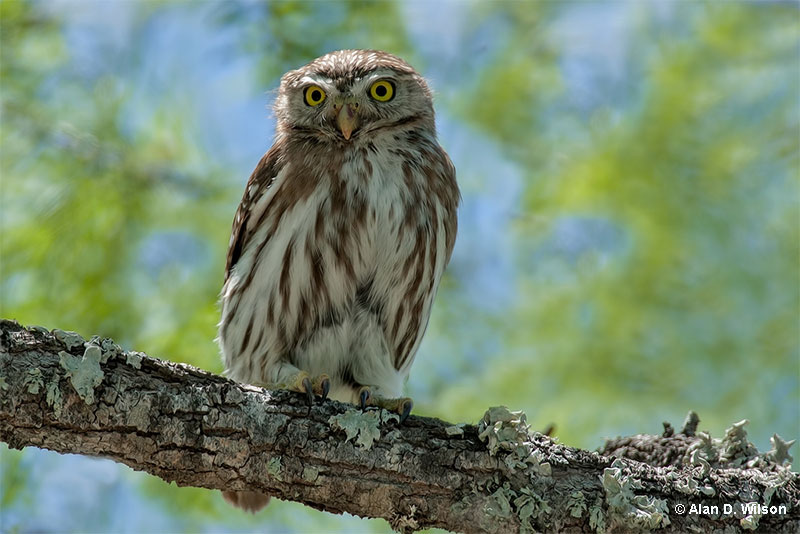
- Range: Permanent, rare resident in a few small areas of southern Arizona and southern Texas.
- Length: 6.75 inches
- Wingspan: 12 inches
- Call: (Write their distinctive call)
The Ferruginous Pygmy Owl is a small, gray and reddish-brown owl with two large black spots on the back of its head. It has a reddish tail with dark bars, fine white streaks on its crown, and brown streaks on pale underparts.
Both sexes look alike, although females are a bit larger.
This rare diurnal owl species lives in desert and subtropical forest habitats.
Key Identifications:
- Small reddish-brown or brown and gray owl with streaks and two black marks on the back of its round head.
- Streaked underparts and a reddish tail.
- Lives in desert and subtropical forest habitats.
- Quickly flies out from a perch to catch small birds, bugs, and lizards.
The Ferruginous Pygmy Owl lives in desert and subtropical habitats in southern Arizona and southern Texas. It nests in tree cavities and is identified by its small size, streaks and black marks on the back of its round head, and reddish tail. This species can catch birds as big as itself!
13. Short-eared Owl
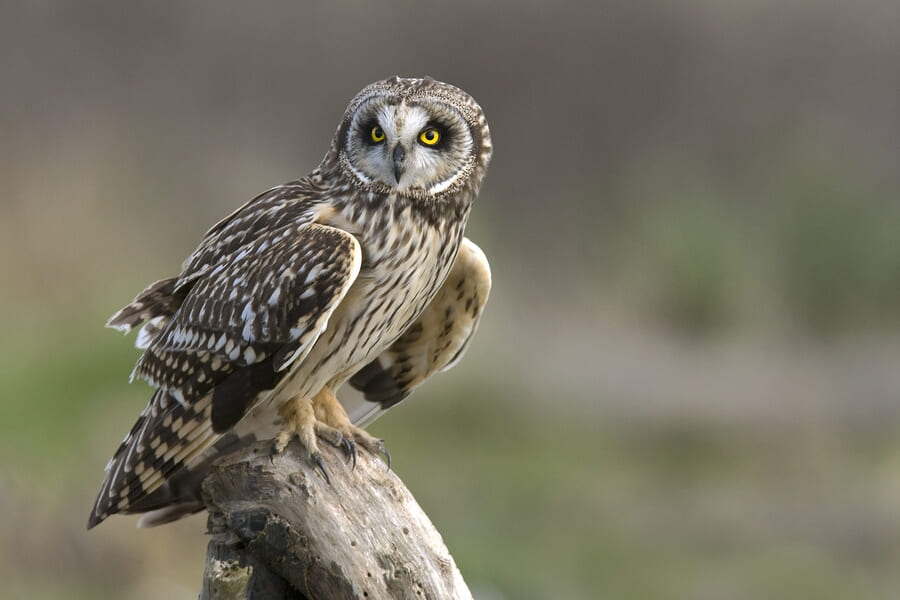
- Range: Summer resident in Alaska, Canada, and the western and central USA. Northern birds migrate to the USA, south to California and Texas.
- Length: 15 inches
- Wingspan: 38 inches
- Call: Makes a hoarse, raspy, cat-like call, “rehw”.
The Short-eared Owl is a medium-sized, pale brown owl with dark eye patches on a pale face. They have a dark breast and streaks on pale underparts. This species has long wings with buff wing patches.
Both sexes look similar but females are a bit larger and usually darker and buffier.
This owl is active day and night in open fields.
Key Identifications:
- Medium-sized pale brown and buffy owl with very short ear tufts.
- Dark eye patches on a pale face and long wings with buff patches near the wingtips.
- Nests on the ground in dense vegetation.
- Glides over open fields to catch small animals on the ground.
The Short-eared Owl lives in open habitats in Alaska, Canada, and much of the USA. Short-eared Owls can be spotted in Arizona. It nests on the ground in dense vegetation. This species is identified by its dark eye patches on a pale face, and long wings with buff patches near the wingtips. On account of their long migrations, Short-eared Owl have become established on Hawaii, and the Galapagos Islands.
Owls In Arizona – Frequently Asked Questions
What owls are common in Arizona?
The Great Horned Owl, Western Screech-Owl, and the Burrowing Owl are the three most common owls in Arizona. According to sightings on the eBird platform, these owl species are seen more than any other owls in the state.
What is the large owl in Phoenix?
The Great Horned Owl is the large owl in Phoenix. This owl species is one of the biggest owls in the country.
Does Phoenix have owls?
Yes, at least four owl species live in Phoenix.
Are there owls in southern Arizona?
Yes, there are several owl species in southern Arizona.


